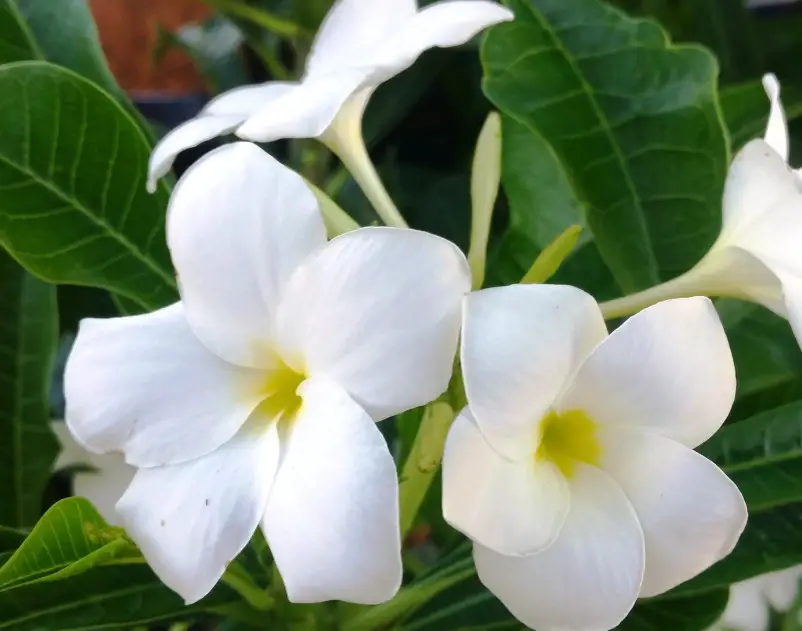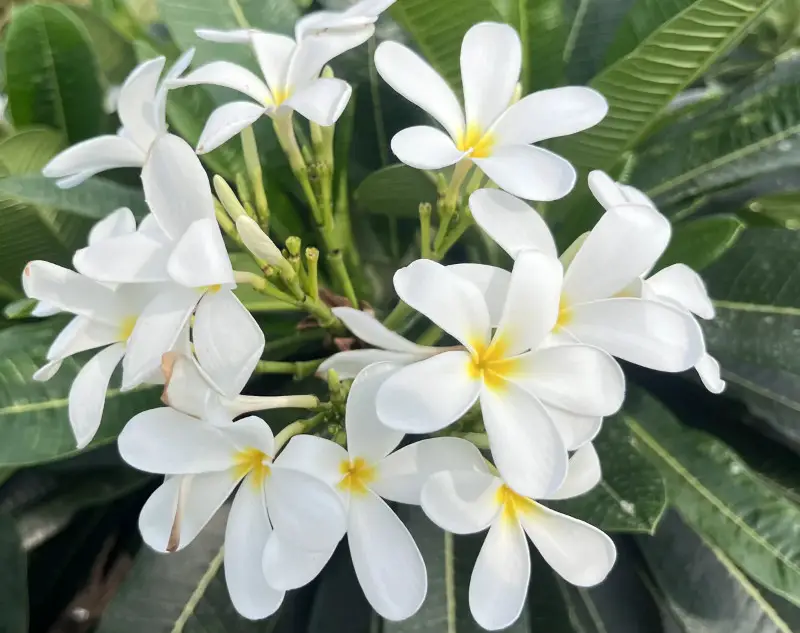Plumeria Pudica, adorned with enchanting flowers and elegant leaves, serves as an accent in gardens and landscapes alike. Cultivating this tropical gem requires meticulous care and specialized growing methods to nurture its vitality and appeal.
In this article, we show you how to plant and care for Plumeria Pudica so that it grows optimally and flowers abundantly. Whether you possess the seasoned expertise of a seasoned gardener or the budding curiosity of a new enthusiast, we invite you to join us in caring for this beautiful botanical wonder.
About Plumeria Pudica

Plumeria pudica, commonly known as plumeria or frangipani, is a delightful tree belonging to the Apocynaceae family. This tropical beauty graces gardens and landscapes with its enchanting presence. Characterized by its slender trunk and sprawling canopy, it reaches a mature height of 10 to 30 feet tall, spreading out 20 to 25 feet wide.
One of the remarkable features of Plumeria pudica is its adaptability to different light conditions. Thriving in both full sun and partial shade, it can be cultivated in a variety of environments. Its preference for well-drained soil, whether loamy or sandy, makes it an excellent choice for gardens with different soil types. Additionally, Plumeria pudica shows resilience in varying pH levels, thriving in both acidic and neutral soils.
The captivating beauty of Plumeria pudica truly shines during its blooming season, which occurs in the summer and fall. Its flowers, which come in a range of colors including white, yellow, pink, red, and orange, adorn the tree with a stunning display of hues, attracting pollinators and admirers alike.
Plumeria pudica is well-suited to USDA hardiness zones 10 to 11, which encompass warm climates conducive to its growth. Originating from North America, South America, and the Caribbean, this species carries a rich history and cultural significance in these regions.
How to grow Plumeria Pudica
Growing plumeria successfully requires attention to specific care requirements. Firstly, choose a sunny location with well-drained soil, as plumeria thrives in these conditions. When planting, ensure the hole is generously wide and deep enough to accommodate the root ball. After planting, tamp down the soil and water deeply to promote root establishment.
Due to its shallow root system, it’s beneficial to place large rocks over the root zone to prevent root disturbance from wind. Regular watering, particularly during the establishment phase, is crucial for healthy growth. Once established, plumeria should receive about 1 inch of water per week, adjusting as needed based on rainfall.
Protecting plumeria from temperatures below 50 degrees Fahrenheit is essential, as it is sensitive to cold. For potted plumeria, fertilize monthly during the active growing season to support robust growth.
Plumeria Pudica Care Guide
Light
Plumeria Pudica, like many tropical flowers, thrives in environments with ample sunlight. Ideally, they should be exposed to full sun for at least six hours each day to ensure healthy growth and abundant blooming. While they can tolerate partial shade, providing them with plenty of sunshine will promote the best results. With proper light exposure, your Plumeria Pudica will flourish and reward you with its stunning blossoms.
Soil
Plumeria plants are versatile when it comes to soil preferences, although they do have some specific needs for optimal growth. While they prefer loamy, nutrient-rich soil, they can adapt to various soil types as long as proper drainage is ensured. It’s crucial to avoid locations with overly soggy soil, as this can lead to root rot, damaging the plant’s health. Maintaining a slightly acidic to neutral soil pH, ideally between 6.5 and 7.0, provides the best conditions for Plumeria Pudica to thrive.
Water
Proper watering is crucial for the health and vitality of Plumeria Pudica plants. Established plumeria typically require about 1 inch of water per week, but this can vary depending on their exposure to sunlight. In locations where the plant receives full sun for most of the day, watering needs may increase, necessitating more frequent watering, especially in the absence of rainfall.
When watering, it’s important to ensure thorough saturation of the soil, allowing it to dry out between waterings to prevent overwatering, which can lead to root rot. During the winter dormancy period, outdoor plumeria in the landscape should not be watered, as they naturally require less moisture during this time. However, indoor plumeria that are dormant may still need infrequent watering, typically every two weeks, ensuring the soil never fully dries out.
Temperature and Humidity
Plumeria, being a tropical plant, flourishes in warm, tropical environments characterized by high humidity levels. It thrives in climates where temperatures remain consistently warm and frost is absent. Exposure to frost can severely damage or even kill plumeria plants, so it’s crucial to protect them from cold temperatures.
Fertilizer
For established plumeria growing in the landscape, regular fertilization may not be necessary unless the soil quality is poor. However, at the beginning of the growing season, a bloom-boosting fertilizer with high phosphorus content is recommended to promote abundant flowering. It’s important to avoid fertilizers high in nitrogen, as these can encourage excessive foliage growth at the expense of flowers.
On the other hand, potted plumeria plants have different needs due to nutrient loss from frequent watering. To compensate for this loss, it’s advisable to fertilize potted plants with the same high-phosphorus fertilizer approximately once a month during the active growing season.
Pruning
Pruning plumeria is generally minimal, unless you desire to shape or train the plant differently. If you wish to establish a single central trunk or create a shorter, denser shrub, pruning can be done in late winter or early spring before new growth begins. During this time, consider removing lower branches near the trunk or cutting back all branches to about half of their length.
It’s essential to exercise caution when pruning plumeria, as the plant typically only branches out after an injury or flowering. Cutting too much can reduce blooming in the following year, as the tips of the branches are responsible for producing the plant’s flowers. Therefore, it’s advisable to be conservative when pruning to maintain the plant’s vitality and ensure abundant blooms in the future.
Propagating Plumeria Pudica

Propagating plumeria can be done through several methods, including:
- Cuttings: This is the most common method. Take a cutting from a healthy, mature plumeria plant, ensuring it’s at least 12 inches long and has several leaf nodes. Allow the cutting to dry for a few days until the cut end forms a callus. Then, plant the cutting in well-draining soil and keep it moist until roots develop.
- Seeds: Plumeria seeds can also be used for propagation, although this method takes longer to produce mature plants. Collect seeds from ripe pods and plant them in a well-draining potting mix. Keep the soil consistently moist and provide warmth to encourage germination.
- Air Layering: This technique involves making a small incision on a healthy branch and wrapping it with moist sphagnum moss or a rooting hormone. Once roots develop, the branch can be cut and planted separately.
- Grafting: Grafting involves joining a piece of plumeria stem (scion) onto a rootstock from a different plant. This method is more advanced and requires specific skills and tools.
Regardless of the method chosen, it’s important to provide the right conditions for the plumeria cuttings or seeds to root and grow. This includes using well-draining soil, providing adequate warmth and humidity, and avoiding overwatering. With patience and proper care, you can successfully propagate plumeria plants to expand your collection or share with others.
How to Grow Plumeria Pudica From Seed
While it is technically possible to grow plumeria from seeds, it’s not the most recommended method for propagation. Plumeria seeds are not commonly available, and even if you manage to obtain some, there’s no guarantee of their viability. Furthermore, growing plumeria from seeds requires a considerable amount of patience, as it can take five years or more for the plant to reach the flowering stage.
Additionally, there’s a high likelihood that the resulting plant won’t be true to the parent, which can be disappointing for growers seeking specific characteristics. As a result, many enthusiasts opt for other propagation methods, such as cuttings or grafting, to ensure more predictable and faster results when growing plumeria.
Common Pests & Plant Diseases
Plumeria is generally resilient to serious pests and diseases, but it can still fall prey to common greenhouse and houseplant pests such as whiteflies, mealybugs, and spider mites. Prompt action using insecticidal soap can effectively control these pests before they escalate into an infestation, safeguarding the health of the plant.
In addition to pests, plumeria is susceptible to fungal diseases like plumeria rust, black tip fungus, and leaf spot. These diseases can affect the foliage and overall health of the plant if left untreated. Proper care, including maintaining good air circulation, avoiding overhead watering, and promptly removing any infected leaves, can help prevent the spread of fungal diseases and preserve the vitality of the plumeria plant.
How to Induce Blooming Plumeria Pudica

Encouraging plumeria to bloom can be a rewarding endeavor, but it requires attention to specific factors. Typically, plumeria blooms between May and November, with the exact timing influenced by the species and local climate conditions. While each bloom may last for two weeks or more, individual flowers typically grace the plant for only a day or two.
Variability exists among cultivars regarding the number of flowers per cluster, ranging from as few as 50 to as many as 200 blooms. Additionally, the number of branch tips producing flowers varies widely among different plumeria varieties. Some may have only one out of 10 branch tips bearing flowers, while others boast six out of 10.
For optimal bloom production, selecting a plumeria variety known for its profuse blooming habit is advisable. Furthermore, deadheading spent flowers is essential to promote continuous blooming and prevent the formation of seed pods. By carefully tending to these factors, you can encourage your plumeria plant to bloom abundantly, adorning your garden or landscape with its exquisite blossoms throughout the blooming season.






